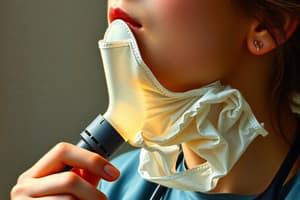Podcast
Questions and Answers
What is a potential complication that can arise from dislodgement of a tracheostomy tube?
What is a potential complication that can arise from dislodgement of a tracheostomy tube?
- Enhanced oxygen saturation
- Reduced risk of infection
- Improved airway clearance
- Tracheal stenosis (correct)
Which of the following accurately describes decannulation in tracheostomy care?
Which of the following accurately describes decannulation in tracheostomy care?
- It refers to the insertion of a tracheostomy tube.
- It is the procedure of replacing a dislodged tube.
- It describes the removal of the tracheostomy tube once the need has resolved. (correct)
- It is the temporary closure of the tracheostomy stoma.
What should be monitored in patients after a tracheostomy procedure to prevent complications?
What should be monitored in patients after a tracheostomy procedure to prevent complications?
- Patient's ability to speak
- Level of consciousness only
- Core body temperature exclusively
- Signs of aspiration pneumonia (correct)
In the context of tracheostomy tubes, what is the primary purpose of using fenestrated tubes?
In the context of tracheostomy tubes, what is the primary purpose of using fenestrated tubes?
What is a symptom of pneumothorax that a nurse should assess for?
What is a symptom of pneumothorax that a nurse should assess for?
What is a primary advantage of using tracheostomy tubes with an inner cannula?
What is a primary advantage of using tracheostomy tubes with an inner cannula?
Which type of tracheostomy tube is specifically designed to allow a patient to speak?
Which type of tracheostomy tube is specifically designed to allow a patient to speak?
What is a potential complication of not using an inner cannula in tracheostomy care?
What is a potential complication of not using an inner cannula in tracheostomy care?
In what situation is it most appropriate to use a cuffed tracheostomy tube?
In what situation is it most appropriate to use a cuffed tracheostomy tube?
Which of the following statements about fenestrated tracheostomy tubes is false?
Which of the following statements about fenestrated tracheostomy tubes is false?
What is the primary function of fenestrated tubes in tracheostomy care?
What is the primary function of fenestrated tubes in tracheostomy care?
What is an important consideration for a patient using a fenestrated tube to speak?
What is an important consideration for a patient using a fenestrated tube to speak?
Which of the following complications is commonly associated with tracheostomy procedures?
Which of the following complications is commonly associated with tracheostomy procedures?
When caring for a patient with a tracheostomy, what nursing intervention is essential to prevent airway obstruction?
When caring for a patient with a tracheostomy, what nursing intervention is essential to prevent airway obstruction?
What should the nurse monitor for in a patient using a fenestrated tracheostomy tube?
What should the nurse monitor for in a patient using a fenestrated tracheostomy tube?
How does a patient improve the strength needed to exhale through a fenestrated tracheostomy tube for speech?
How does a patient improve the strength needed to exhale through a fenestrated tracheostomy tube for speech?
Which of the following behaviors indicates the need for further education for a tracheostomy patient?
Which of the following behaviors indicates the need for further education for a tracheostomy patient?
Which nursing diagnosis is likely appropriate for a patient with a newly created tracheostomy?
Which nursing diagnosis is likely appropriate for a patient with a newly created tracheostomy?
Flashcards are hidden until you start studying
Study Notes
Tracheostomy
- Used for patients requiring long-term airway support
- Tracheotomy: Surgical incision in the trachea just below the larynx
- Tracheostomy: Opening made for the tracheostomy tube
Types of Tracheostomy Tubes
- Cuffed Tracheostomy Tubes: Used to provide a safe and comfortable airway
- Un-cuffed Tracheostomy Tubes: Used when the patient is able to breathe on their own through their mouth and nose
- Tracheostomy Tubes with an Inner Cannula: Important for patients who have a lot of secretions, easier to clean, and easier to manage mucus plugs
- Fenestrated Tracheostomy Tubes: Allow air to move around the trach and through the vocal cords, used for patients who want to talk
Decannulation
- Process of tracheostomy tube removal once the need for the tube has resolved
- Dislodgement/accidental complications: Tracheal stenosis, bleeding, infection, aspiration pneumonia, and fistula formation from the trachea to esophagus
Pleural Effusion - Symptoms and Causes
- Symptoms: Chest pain, dyspnea, decrease in O2 saturation
- Causes: Trauma, lung disease, invasive procedures, spontaneous
Chest Trauma
- Blunt: No break in the skin, more life-threatening as not as obvious and diagnosis is more difficult
- Penetrating: Wound caused by impalement or an object passing through the tissue, severity is based on organ tissue damage
Pneumothorax/Hemothorax
- Pneumothorax: Collection of air in the pleural space, symptoms include chest pain, dyspnea, decrease in O2 saturation
- Causes: Trauma, lung disease, invasive procedure, spontaneous
- May vary depending on the size of the pneumothorax and the signs and symptoms the patient is experiencing.
Studying That Suits You
Use AI to generate personalized quizzes and flashcards to suit your learning preferences.




